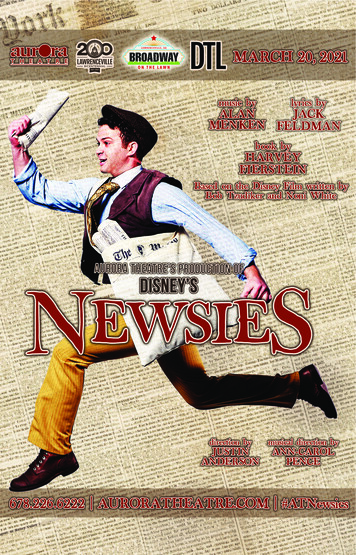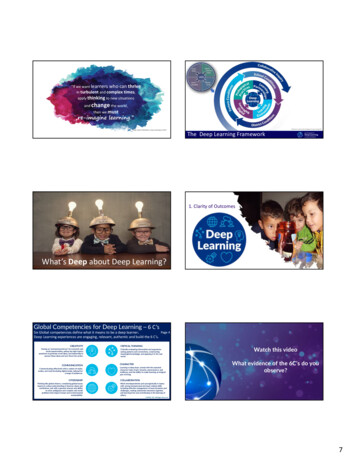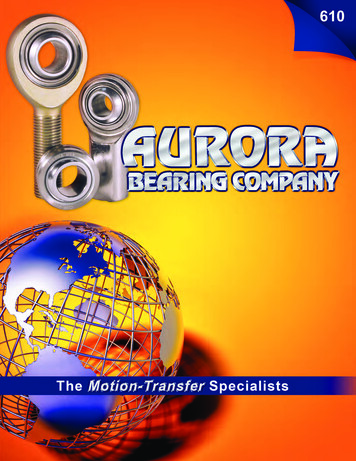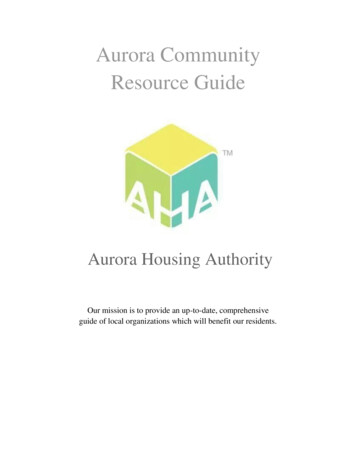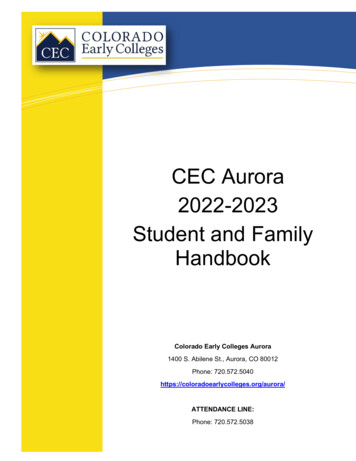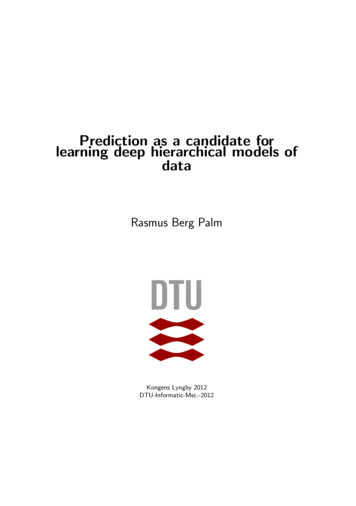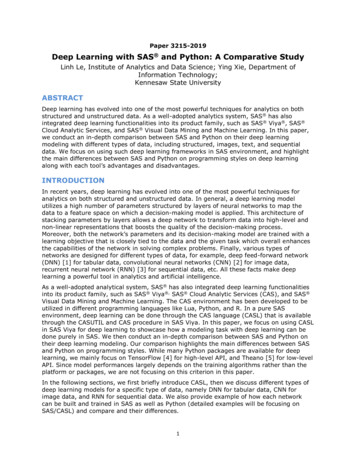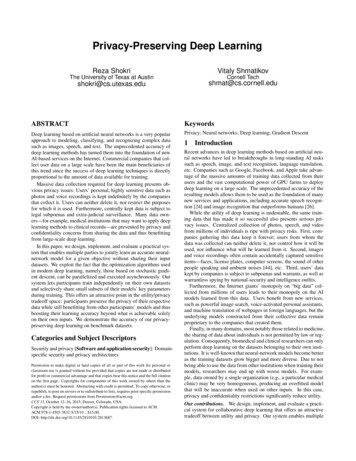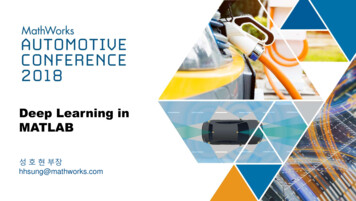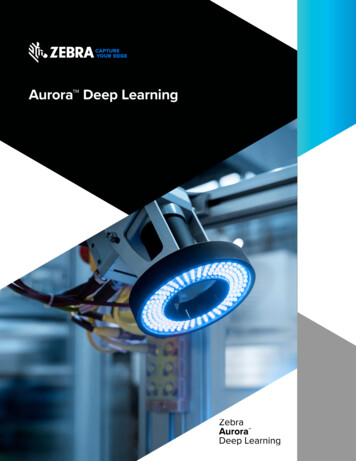
Transcription
Aurora Deep Learning
BROCHUREAURORA DEEP LEARNINGThe Aurora Vision for OEM PortfolioIntuitive Software for Industrial Image AnalysisZebra is now a leading provider of user-friendly machine vision software for industrial image analysis. Our comprehensiveAurora Vision for OEM portfolio of graphical software helps users easily create custom machine vision applications.Enhanced and optimized by machine vision experts for nearly 15 years, these world-class software products – Aurora Vision Studio, Aurora Vision Library, Aurora Deep Learning – offer state-of-the-art, industrial reliability, quality, andspeed. They have been used by machine builders, vision system integrators, robotic designers, and industrial end usersworldwide to enable rapid development of vision applications in verticals ranging from food production and retail toagriculture and healthcare.Ready-made tools for dataflow and comprehensive image analysis filters are all hardware-agnostic – to suit yourcustomers’ specific needs. They enable your engineers to quickly and easily construct powerful, customized machinevision applications to augment your operations.Introducing Aurora Deep LearningDeep Learning to Further Enhance Solution QualityThis add-on product within our comprehensive Aurora for OEM software portfolio offers a complete set of industrialquality deep learning tools which can be used to solve problems that are far too complex for traditional machine visionalgorithms and further enhance the outputs of Aurora Vision Studio and Aurora Vision Library software.Features & anomaly detection, advanced optical character recognition (OCR) technology, and deep learning capabilitiescombine to recognize the way real-world images are used – and evolve accordingly.Internally, Aurora Deep Learning uses large neural networks designed and optimized by our research team for use inindustrial inspection systems.Together with Aurora Vision Studio, Aurora Deep Learning constitutes a complete solution for training and deployingmodern machine vision systems.Learns from just a few samplesTypical applications require between20 and 50 images for training.More sample images are betterbut the Aurora Deep Learningsoftware learns key characteristicsfrom a limited training set and thengenerates thousands of new artificialsamples for effective training.2zebra technologiesWorks on GPU and CPUA modern GPU is required foreffective training. At production,you can use either GPU or CPU.Using GPU will typically be 3-10 timesfaster (with the exception of ObjectClassification, which is equally fast onCPU).High performance guaranteedTypical training time on a GPU takesusually 5-15 minutes. The inferencetime varies, depending on the tooland hardware – from between 5msand 100ms per image. The highestperformance is guaranteed byusing Aurora Weaver, our industrialinference engine.
BROCHUREAURORA DEEP LEARNINGAll-In-One Software PackageThe Aurora Vision for OEM portfolio offers the most comprehensive approach to the development of custom machinevision applications:32D & 3D algorithmsC and .NET librariesRapid developmentenvironmentHMI DesignerTechnical supportand know-howDeep Learningzebra technologies
BROCHUREAURORA DEEP LEARNINGAurora Deep Learning vs Traditional Machine VisionAurora Deep Learning is a new reliable solution for machine vision problems that could not have been solved before.There are, however, applications that can still only be realized with traditional methods. How do you know whichapproach is better? Here is a quick guide:Deep LearningTraditional machine visionTypical applications:Typical applications: Surface inspection (cracks, scratches)Food, plant, wood inspectionPlastics injection moldingTextile inspectionMedical imagingDimensional measurementsCode readingPresence or absence checkingLocation of fiducials on PCBPrint inspectionTypical characteristics:Typical characteristics: Deformable objects Variable orientation Customer provides vague specificationswith examples of good and bad parts Reliability: 99% Rigid objects Fixed orientation Customer provides formal specificationswith tolerances Reliability: 100%Hardware RequirementsAurora Deep Learning can work on a standard industrialPC. But for better performance, we recommend usingmodern GPU boards from the NVIDIA GeForce andTesla series with compute capability 3.5 or higher.4zebra technologiesTraining Interface for end users Aurora Deep Learning allows end users who are nonvision experts to retrain a Deep Learning model on afactory floor. Users of Aurora Vision Library can create their owntraining interface for end users using the C API.
BROCHUREAURORA DEEP LEARNINGTraining Procedure123Collect and normalize images Acquire between 20 and 50 images, both good and bad,representing all possible object variations, and save themto your hard drive. Make sure the object scale, orientation and lighting are asconsistent as possible.Training Open Aurora Vision Studio and add one of the DeepLearning tools. Open an editor associated with the tool and load yourtraining images.Execute Run the program and see the results. Go back to Step 1 or 2 until results are fully satisfactory.Training and Validation SetsIn Aurora Deep Learning, as in all fields of machine learning, it is very importantto follow the correct methodology. The most important rule is to separate theTraining set from the Validation set.The Training set is a set of samples used for creating a model. We cannot use itto measure the model’s performance, as this often generates overly optimisticresults. Thus, we use separate data – the Validation set – to evaluate the model.Our Deep Learning tool automatically creates both sets from the samplesprovided by the user.5zebra technologies
BROCHUREAURORA DEEP LEARNINGApplication ExamplesFeature Detection (Supervised)In the supervised detection mode, the user needs to carefully label pixels corresponding to defects in the training images.Aurora Deep Learning then learns to distinguish good and bad features by looking for their key characteristics.Photovoltaic Panels InspectionIn this application, cracks and scratches must be detected on a surfacethat includes complicated features. Using traditional methods, thisrequires complicated algorithms with dozens of parameters whichmust then be adjusted for each type of solar panel. Using Aurora Deep Learning, it is enough to train the system in the supervised modewith just one tool.Satellite Image SegmentationSatellite images are difficult to analyze as they include a huge varietyof features. Nevertheless, Aurora Deep Learning can be trained todetect roads and buildings with very high reliability.Other ExamplesMarble cracks6zebra technologiesWood knotsFabric defects
BROCHUREAURORA DEEP LEARNINGAnomaly Detection (Semi-Unsupervised)In the semi-unsupervised mode, training is simpler. A defect is not strictly defined – the tool is trained with good samplesand then looks for deviations of any kind.Aurora Deep Learning provides two variants of the Anomaly Detection tool. They are both designed for detectinganomalies, but in a different way. The first uses image reconstruction techniques, while the second performs one-classclassification of every part of the input image. When highly precise defect heatmaps are needed – even at the expense ofhigher computational time – the first variant is recommended.Package VerificationWhen a sushi box is delivered to the market, each of theelements must be correctly placed at a designated position.Defects are difficult to define when acceptable objects varyin appearance. The solution is to use the unsupervised DeepLearning mode that detects any significant variation fromwhat the tool has been exposed to in the training phase.Plastics Injection MoldingInjection molding is a complex process, with manyproduction problems that might occur. Plastic objects mayalso include folding or other kinds of shape deviations thatare acceptable for the customer. Aurora Deep Learningcan learn all the acceptable deviations from the providedsamples and then detect anomalies of any type whenrunning on a production line.7zebra technologies
BROCHUREAURORA DEEP LEARNINGObject ClassificationCaps: Front or BackPlastic caps may sometimes accidently flip in the productionmachine. If the customer would like to detect such a situation,the task can be completed using traditional methods. However,it requires an expert to design an algorithm specific to thisapplication. Alternatively, Aurora Deep Learning can be usedto automatically learn to recognize the front and the back of acap from a set of training pictures.3D Alloy Wheel IdentificationThere may be hundreds of different alloy wheel typesbeing manufactured at a single plant. The identificationof the particular model among such variety is virtuallyimpossible using traditional methods. Template matchingwould require a huge amount of time, trying to matchhundreds of models, while handcrafting of bespokemodels would simply require too much development andmaintenance. Aurora Deep Learning is an ideal solution,allowing the program to learn directly from samplepictures and come up with reliable results.8zebra technologies
BROCHUREAURORA DEEP LEARNINGBatteries ClassificationBatteries can be found in every room in the house nowadays.Unfortunately, most of them end up in trash cans and then aretaken to landfill sites, where they begin to rot away and may leakdangerous chemicals into the ground, causing soil and waterpollution.Aurora Deep Learning tools make classification of usedbatteries easy. Simply teach your program what selected typesof batteries look like and it will classify them automatically.The range of this application is extremely wide – from sortingbatteries in big recycling plants to small automatic batterycollection containers in the streets.Food Ingredients ClassificationAlthough it may appear easy at first, especially for a humanbrain, it is very difficult for a traditional machine vision system todistinguish between sugar and flour when it is being transportedat a speed of a few meters per second. In food ingredientspackaging systems, customers use Aurora Deep Learning toensure that the correct material is loaded.Breadcrumbs9zebra technologiesFlourRiceSaltSugar
BROCHUREAURORA DEEP LEARNINGInstance SegmentationThe instance segmentation technique is used to locate, segment, and classify single or multiple objects within an image.Unlike the feature detection technique, this technique detects individual objects and may be able to separate them evenif they touch or overlap.Nuts SegmentationMixed nuts are a very popular snack food, consisting of varioustypes of nuts. As the percentage composition of nuts in apackage should be in accordance with the list of ingredientsprinted on the label, the customer wants to ensure that thecorrect number of each type of nut is going to be packaged.The instance segmentation tool is an ideal solution in suchapplication, as it returns marks corresponding to the segmentedobjects.InputOutputPackage VerificationA typical set of soup greens used in Europe is packaged on awhite plastic plate in a random position. Production line workersmay sometimes accidently forget to put one of the vegetables onthe plate. Although there is a system that weighs the plates, thecustomer often wants to verify the completeness of the productjust before the sealing process. As there are no two vegetablesthat look the same, the ideal solution is to use deep learningbased segmentation. In the training phase, the customer just hasto mark the regions corresponding to selected vegetables.10zebra technologiesInputOutputInputOutput
BROCHUREAURORA DEEP LEARNINGPoint LocationThe Point Location tool looks for specific shapes, features, or marks that can be identified as points on an input image. Itmay be compared to traditional template matching, but here the tool is trained with multiple samples and becomes robustagainst huge variability in the objects of interest.Tracing BeesThe task that seems impossible to achieve with traditionalmethods of image processing can be done using Aurora DeepLearning tools. In this case we use them to detect bees. Whenit is done, we can check whether they are infected by varroosis– a disease caused by parasitic mites attacking the honeybees. The parasite attaches itself to their bodies and we canuse a characteristic red inflammation spot to classify the beesaccording to their health condition. Not only does this exampleshow that it is an easy solution for a complex task, but also thatAurora software can be used in many different branches ofindustry, e.g., agriculture.Healthy beeBee with varroosisPick and PlaceIn these applications, we need to guide a robotic arm to pick upitems, most typically from a conveyor belt or from a container. Agood example of such application is picking small stem cuttingsand then placing them vertically in pots. Any inaccuracies indetection may cause them to be planted too deep or upsidedown, which will result in cuttings not forming roots. Aurora Deep Learning tools make it possible to quickly locate thedesired parts of the plants and provide accurate results requiredfor this operation.Location accuracy11zebra technologiesLocated points
BROCHUREAURORA DEEP LEARNINGOptical Character RecognitionThe optical character recognition (OCR) capabilities withinAurora Deep Learning are the answer for challengingcharacter recognition projects, in which complex nonuniform backgrounds, blurred, damaged, distorted, orobscured characters, or reflective metal surfaces make itimpossible to use traditional OCR techniques.The tool comes with a ready-to-use neural network that ispre-trained using thousands of different image samples.It can achieve up to 97% accuracy straight out of thebox, even when dealing with very difficult cases, andenables the user to create a robust OCR application in justa few simple steps – without the need for machine visionexpertise.Key features Ready-to-use, comes with a pre-trained neural network. Can deal with difficult OCR cases, impossible to achieveusing traditional methods. Very high accuracy straight out of the box. Easy to use, no need for machine vision expertise. Works on both NVIDIA GPU and CPU.To find out more, visit zebra.com/aurora-for-oemNA and Corporate Headquarters 1 800 423 0442inquiry4@zebra.comAsia-Pacific Headquarters 65 6858 0722contact.apac@zebra.comEMEA comLatin America comZEBRA and the stylized Zebra head are trademarks of Zebra Technologies Corp., registered in many jurisdictions worldwide. All othertrademarks are the property of their respective owners. 2022 Zebra Technologies Corp. and/or its affiliates. 01/05/2022.
This add-on product within our comprehensive Aurora for OEM software portfolio offers a complete set of industrial-quality deep learning tools which can be used to solve problems that are far too complex for traditional machine vision algorithms and further enhance the outputs of Aurora Vision Studio and Aurora Vision Library software.
